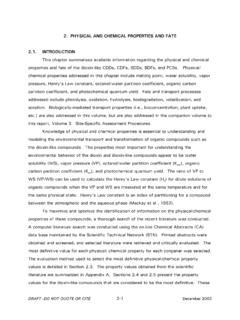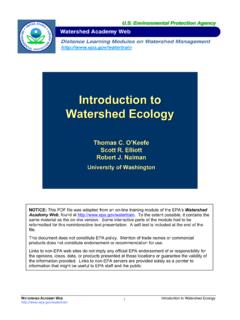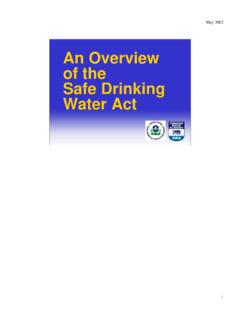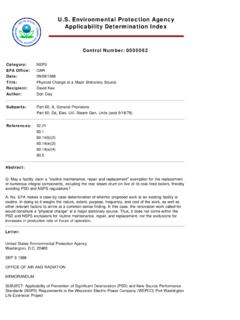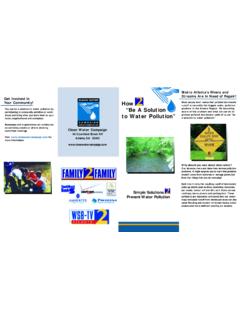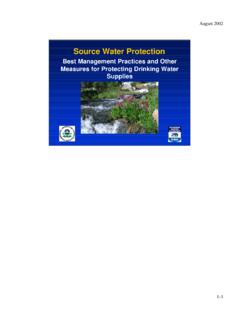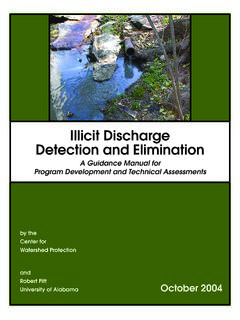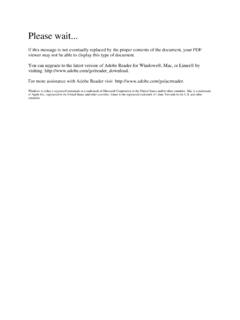Transcription of Watershed Academy Web - Introduction to the Clean Water …
1 Watershed Academy WEB 1 Introduction TO THE Clean Water ACT Introduction to the Clean Water Act NOTICE: This PDF file was adapted from an on-line training module of the EPA s Watershed Academy Web, found at To the extent possible, it contains the same material as the on-line version. Some interactive parts of the module had to be reformatted for this noninteractive text presentation. A self-test is included at the end of the file. This document does not constitute EPA policy. Mention of trade names or commercial products does not constitute endorsement or recommendation for use. Links to non-EPA web sites do not imply any official EPA endorsement of or responsibility for the opinions, ideas, data, or products presented at those locations or guarantee the validity of the information provided. Links to non-EPA servers are provided solely as a pointer to information that might be useful to EPA staff and the public.
2 Watershed Academy WEB 2 Introduction TO THE Clean Water ACT Introduction to the Clean Water Act Introduction The Clean Water Act (CWA) is the cornerstone of surface Water quality protection in the United States. The act does not deal directly with ground Water or with Water quantity issues. Some states have chosen to develop ground Water quality standards (mentioned in the section entitled Introduction to WQS) or Water quality standards that address streamflow specifically. The statute employs various regulatory and non-regulatory tools to sharply reduce direct pollutant discharges into waterways, establish ambient Water quality standards, finance municipal wastewater treatment facilities, and manage polluted runoff. These tools are employed to achieve the broader goal of restoring and maintaining the chemical, physical, and biological integrity of the nation s waters so that they can support the protection and propagation of fish, shellfish, and wildlife and recreation in and on the Water .
3 The basis of the CWA was enacted in 1948 and was called the Federal Water Pollution Control Act, but the act was significantly reorganized and expanded in 1972. " Clean Water Act" became the act's common name with amendments in 1977. The CWA made it unlawful to discharge any pollutant from a point source into navigable waters, unless a permit authorized under the CWA was obtained. EPA's National pollutant discharge Elimination system (NPDES) permit program (found at ) controls these point source discharges. Point sources are discrete conveyances, such as pipes or man-made ditches, that discharge into surface waters. Individual homes that are connected to a municipal system , use a subsurface discharging septic system , or do not have a surface discharge do not need an NPDES permit. Nevertheless, industrial, municipal, and other facilities must obtain permits if their discharges go directly to surface waters.
4 For many years, following the passage of the CWA in 1972, EPA, states, and Indian tribes focused mainly on the chemical aspects of the Water quality integrity goal. During the last decade, however, more attention has been given to physical and biological integrity. Also, in the early decades of the act s implementation, efforts were focused on regulating discharges from traditional point source facilities, such as municipal sewage treatment plants and industrial wastewater facilities, with little attention paid to runoff from streets, construction sites, farms, and other wet-weather sources. Starting in the late 1980s, efforts to address polluted runoff have increased significantly. For nonpoint pollutant runoff, education and voluntary programs, including cost-sharing with landowners, are the key tool.
5 For wet weather point sources like urban storm sewer systems and construction sites, a regulatory approach under the NPDES permit program is being employed. CWA programs, as they evolved over the last decade, have shifted from a program-by-program, source-by-source, pollutant -by- pollutant approach to more holistic Watershed -based strategies. Under a Watershed approach, equal emphasis is placed on protecting healthy waters and restoring impaired ones. A full array of issues are addressed, not just those subject to CWA regulatory authority ( , stream channel erosion). Involving stakeholder groups with developing and Watershed Academy WEB 3 Introduction TO THE Clean Water ACT implementing strategies for achieving and maintaining state Water quality standards and other environmental goals is another hallmark of this approach.
6 History of the Clean Water Act (CWA) The Cuyahoga River was one of the most polluted rivers in the United States (Figure 1). The reach from Akron to Cleveland was devoid of fish throughout the 1950s and 60s. There were at least 13 fires on the Cuyahoga River, the first occurring in 1868. The largest river fire, in 1952, caused more than $1 million in damage to boats and a riverfront office building. Fires erupted on the river several more times before June 22, 1969; on that date a river fire captured the attention of Time magazine, which described the Cuyahoga as the river that "oozes rather than flows" and in which a person "does not drown but decays." The 1969 Cuyahoga River fire mobilized public concern across the nation and helped spur an avalanche of Water pollution control activities resulting in the Clean Water Act, Great Lakes Water Quality Agreement, and the creation of the federal Environmental Protection Agency and the Ohio Environmental Protection Agency (OEPA).
7 Although the Cuyahoga River fire(s) dramatically focused public opinion and motivated action, several federal laws had been in place to regulate activities in surface waters. The Rivers and Harbors Act (Figure 2) addressed projects and activities in navigable waters and harbor and river improvements, such as placing dredged or fill material in waterways, altering channels, and constructing dams, bulkheads, jetties, and other structures. In 1948, Congress enacted the Water Pollution Control Act to "enhance the quality and value of our Water resources and to establish a national policy for the prevention, control and abatement of Water pollution." This was an important step in establishing the basic legal authority for federal regulation of Water quality. The act was amended in 1956 to strengthen enforcement provisions and again in 1965 to establish Water quality standards for surface waters enforceable by state and federal authorities.
8 Incremental adjustments through 1970 beefed-up reporting requirements, enforcement provisions, and added an antidegradation component. Despite the improvements achieved by each amendment to the original act, the result of this sporadic legislation was a hodgepodge of law. Eleven reorganizations and restructurings of Figure 1 Figure 2 Watershed Academy WEB 4 Introduction TO THE Clean Water ACT federal agency responsibilities compounded the difficulty of effectively implementing the law. To solve these problems, the 1972 amendments to the act restructured the authority for Water pollution control and consolidated authority in the Administrator of the Environmental Protection Agency, which was created by Executive Order of the President. Additional adjustments were enacted in 1977 to address long-term funding for wastewater treatment facilities, sludge management, toxic pollutants, and wetland protection; in 1987 to establish stormwater permitting, nonpoint source pollution control, and Great Lakes and Chesapeake Bay protection programs; and again in 2000 to support updated Water quality standards and pathogen monitoring for recreational waters.
9 Throughout the many adjustments to federal Clean Water law, two major approaches are evident: (1) Water quality protection rules based on establishing enforceable standards that apply to the chemical, physical, or biological condition of surface Water bodies; and (2) protection measures based on treatment technology requirements for facilities that discharge effluent, pollutants, wastes, or other substances into Water bodies. Before 1972, many states had so-called Water quality standards that attempted to limit pollutant concentrations in their lakes, rivers, streams, wetlands, and coastal waters. Yet the lack of efficient and effective monitoring and assessment tools and the sheer difficulty in identifying pollutant sources resulted in a cumbersome, slow, ineffective system that was unable to reverse growing pollution levels in the nation s waters.
10 The strength of the 1972 amendments to federal law was the creation of the NPDES permitting system , which required authorization to discharge pollutants from a point source into the waters of the This approach attacking pollution problems by focusing on the sources was extremely successful, because it linked strong enforcement provisions with federal grants to construct wastewater treatment facilities. Regardless, as point source pollutant loads were addressed effectively by hundreds of new treatment plants, the problem with polluted runoff ( , nonpoint source pollution) became more evident. Today, states, tribes, and federal agencies use a dual approach to address Water quality: point sources are controlled by permit programs, effluent limits, monitoring, and enforcement, and Water body integrity is supported by Water quality standards that address all sources of impairment, including point source and nonpoint pollution ( , polluted runoff), habitat degradation caused by changes in runoff patterns, and other stressors (Figure 3).

